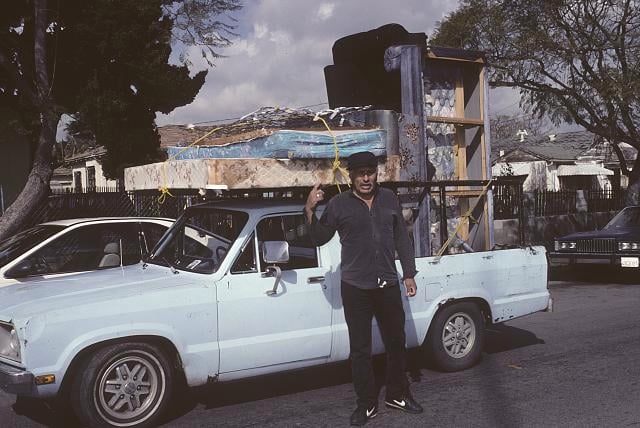
Don Miguel y su troca parked on Budlong Ave., South Los Angeles, 2000.
The following activities and questions are designed to help your students use their noticing skills to move through the poem and develop their thinking skills so they understand its meaning with confidence, using what they’ve noticed as evidence for their interpretations. Read more about the framework upon which these activities are based.
-
Warm-up: Listen to the song “Home” by Phillip Phillips. What lyrics or phrases stand out to you in this song? Why? What makes a home? Why?
-
Before Reading the Poem: Look closely at the photographs here and here. What is different about them? What do they have in common?
-
Reading the Poem: Silently read “The Moving Truck Poem” by Andru Defeye. What do you notice about the poem? Note any words or phrases that stand out to you, or any questions you might have.
-
Listening to the Poem: Enlist two volunteers and listen as the poem is read aloud twice. Write down any additional words and phrases that stand out to you.
-
Small Group Discussion: Share what you noticed about the poem with a small group of students. Based on the details you just shared and the resources from the beginning of class, what impact do you think moving has on the speaker? Why? How might the speaker feel about home?
-
Whole Class Discussion: Join with a small group or a partner. Together, determine the best line in the poem. Then debate why your line is the best line in the entire poem. After, share what this activity made you think about the poem.
-
Extension for Grades 7-8: Look back at the photos from the beginning of class. Write a poem about one of them, or write about something that you feel inspired about.
- Extension for Grades 9-12: At the beginning of class, you discussed what makes a home. After reading this poem, how would it feel to leave? Learn more about one family’s decision to leave home and seek asylum in this video. After watching the video, discuss what you learned with your class. What questions do you still have? What do you want to learn more about? If you have time, watch more videos in the series or bring in a current events article about something of interest.
Teach This Poem was developed for in-person classrooms, but it can be easily adapted for remote learning and hybrid learning models. Please see our list of suggestions for how to adapt this lesson for remote or blended learning.
“He migrated ‘unaccompanied’ to the United States in 1999 when he was nine years old, following the migration of his parents during and shortly after the war. His trip was supposed to take two weeks; it took two months. In the years since, he has lived as an undocumented immigrant documenting immigrant life. This is the story of our times; this, as he describes in his poem “Citizenship,” is the landscape we face: “booth road booth road booth road office building then the fence / fence fence fence.” Read an interview with Javier Zamora on poetry and migration.
